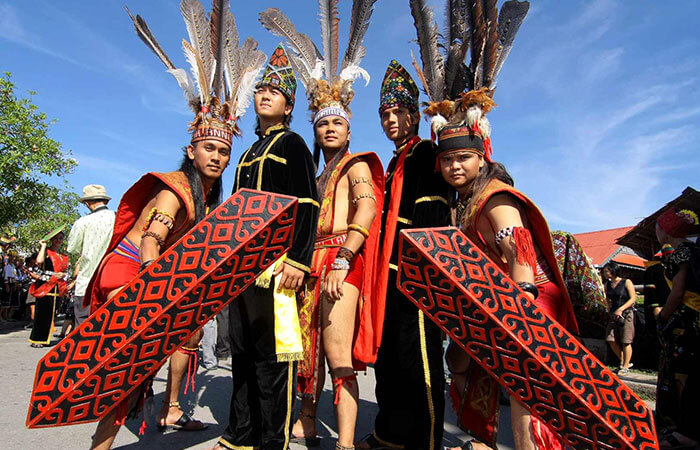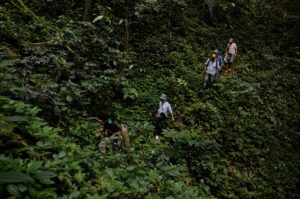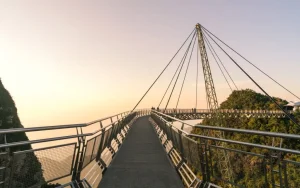If you never heard of Sabah, this place is one of Southeast Asia’s highest peaks and Malaysia’s thirteen states shares its lush landscapes with Sarawak, Brunei, and Indonesian Kalimantan.
It unfolds as a treasure trove of natural diversity, vibrant cultures, exciting adventures, pristine beaches, and delectable cuisines that tantalize adventurous taste buds. From the unparalleled beauty of the world’s largest flower, the Rafflesia, to the towering majesty of Mount Kinabalu, one of Southeast Asia’s highest peaks, and the mesmerizing depths of Sipadan Island, among the planet’s premier dive sites!
Ethnics
1. Kadazandusun
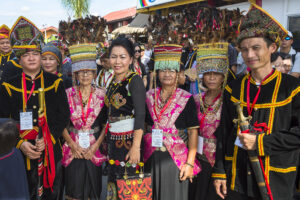
This term is an amalgamation of two distinct ethnic groups, the Kadazan and the Dusun, who share certain cultural similarities while maintaining their unique identities.
Language and Identity
The Kadazan people have their own language, Kadazan, and identify strongly with their cultural heritage. They are predominantly found in the central and west-coastal regions of Sabah.
Traditionally, the Kadazan were skilled in agriculture, cultivating rice and other crops. The annual Harvest Festival, known as Kaamatan, is a significant celebration that reflects their agrarian roots.
The Dusun people encompass a variety of subgroups, each with its own distinct dialects and traditions. Subgroups include the Dusun Tobilung, Dusun Tatana, and others.
These cultures are spread across different regions of Sabah, including the interior areas. Their historical connection to agriculture and the land is reflected in their cultural practices.
Cultural and Religious Aspects
Animistic Beliefs. Both the Kadazan and Dusun traditionally held animistic beliefs, with a deep reverence for nature and spirits. However, like many indigenous communities, there has been a blending of traditional beliefs with other religions, including Christianity.
Kaamatan Festiva
The Kaamatan Festival, also known as Harvest Festival, is a major celebration for the Kadazandusun communities. It typically takes place in May and involves rituals, cultural performances, traditional sports, and the crowning of the Unduk Ngadau (Harvest Queen).
Cultural Dress and Arts
The Kadazandusun people have distinctive traditional attire. The women often wear brightly colored costumes adorned with beadwork, while men may wear traditional garments for special occasions.
Traditional music and dance are integral to Kadazandusun culture. The Sumazau dance is a well-known traditional dance form performed during celebrations.
Efforts are ongoing to preserve and promote Kadazandusun cultural heritage. Cultural organizations, festivals, and educational initiatives play a role in sustaining their traditions.
While some Kadazandusun communities maintain traditional agricultural practices, others have diversified into various livelihoods, contributing to the modernization of their communities.
2. Murut
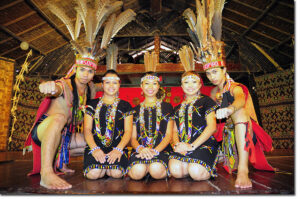
Living in the area from Tenom to Kalabakan, the term “Murut” was given by the people of Brunei, meaning people of the hills or people from the remote mountainous interior.
The Murut are an indigenous ethnic group in Borneo, particularly in the northern regions of Borneo, which includes parts of Malaysia (Sabah and Sarawak), Brunei, and Indonesia (Kalimantan). The term “Murut” is said to mean “hill people” or “people of the hills,” emphasizing their historical connection to hilly and mountainous landscapes. Here are some key aspects of the Murut ethnics:
Cultural Diversity
The Murut comprise various subgroups, and there can be cultural variations among them. Subgroups include the Tagol Murut, Timugon Murut, Paluan Murut, and others.
Traditional Lifestyle
Historically, the Murut were known for their traditional agricultural practices, cultivating hill rice and engaging in hunting and gathering. Their way of life was closely tied to the natural environment.
Cultural Practices
The Murut have unique cultural practices, including traditional dances, rituals, and ceremonies. These often relate to agriculture, harvest celebrations, and rites of passage.
Art and Craft
Murut communities are skilled in traditional crafts, including beadwork, weaving, and wood carving. These crafts often have cultural and symbolic significance.
Beliefs and Spirituality
Traditional Murut beliefs are animistic, with a strong connection to nature and the spirit world. However, like many indigenous groups, there has been some influence from other religions over time.
Community Identity
The Murut people take pride in their cultural identity and heritage. Efforts are made to preserve and showcase their traditions through cultural events and festivals.
Economic Activities
While some Murut communities maintain traditional agricultural practices, others have diversified into various economic activities, adapting to modern livelihoods.
Challenges and Resilience
Murut communities, like many indigenous groups, face challenges such as cultural preservation, economic opportunities, and environmental changes. However, there are ongoing efforts to address these challenges and celebrate their resilience.
Modern Influences
In contemporary times, Murut communities have been influenced by modernization, education, and exposure to external cultures. Balancing traditional practices with modern realities is a part of their evolving identity.
3. Bajau/Sama
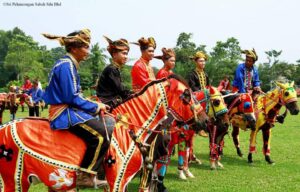
The Bajau or Sama people in Sabah, Malaysia, are an indigenous ethnic group with a distinct cultural identity and a rich maritime heritage.
Maritime Culture
The Bajau/Sama people are often referred to as “Sea Gypsies” due to their historical reliance on the sea for their livelihoods. Traditionally, they were skilled seafarers and fishermen, navigating the coastal waters and living on houseboats or stilt houses near the shore.
Diverse Subgroups
The community is not homogenous and consists of several subgroups, each with its own unique practices and dialects. These subgroups include the Bajau Laut (Sea Bajau), Bajau Darat (Land Bajau), and others.
Language and Dialects
The Bajau/Sama community speaks various dialects of the Sama-Bajau language. Different subgroups may have distinct linguistic variations that contribute to the cultural diversity within the community.
Nomadic Traditions
Historically, some Bajau/Sama groups were known for their semi-nomadic lifestyle, moving between coastal and island locations in search of marine resources. This mobility reflected their intimate connection with the sea.
Indigenous Beliefs
The people often adhere to a blend of indigenous beliefs, including animism and traditional rituals. However, due to historical influences, some have also embraced Islam, and there is a significant Muslim presence within the community.
Unique Festivals
Festivals and ceremonies play a vital role in Bajau/Sama culture. The annual Regatta Lepa-Lepa in Semporna, for example, is a colorful boat festival that celebrates the maritime heritage of the Bajau Laut. It attracts visitors from around the region.
Adaptation to Modernity
In contemporary times, many Bajau/Sama people have transitioned to more settled lifestyles, engaging in various occupations beyond traditional fishing. However, there are still communities that maintain aspects of their maritime heritage, practicing traditional fishing methods.
Sabah Architecture
For this one, we’re going to talk about special types of buildings made by the Rungus and Murut communities. They have houses called Rungus Longhouse and Murut Longhouse. The Rungus Longhouse is special because its bedrooms face Mount Kinabalu. Both houses are used as homes and for protection. The Murut Longhouse is known for being safe and having a design with a long space for families and a central area for activities. Also, the “Lepa” boat is described, saying it’s used for both traveling and living. It’s made from different types of wood and has a roof made from nipa palm leaves.
1. Rumah Panjang Rungus (Rungus Longhouse)

Constructed by the Rungus community known as Vinatang.
The uniqueness lies in the bedrooms being built with the head positioned at the exact angle facing Mount Kinabalu.
Functions
a) Residence and defensive fortress.
b) Foster cooperation and protect its members.
Construction Materials: Round wood, bamboo, bark, and nipa palm leaves.
How to get there?
If your chosen longhouse is in Kudat or Matunggong, plan your journey to these areas. You can use public transportation, rent a car, or hire a local guide.
By Car
Renting a car gives you flexibility. Roads are relatively good, and you can navigate at your own pace.
Public Transportation
Buses or vans may operate from major towns to Kudat. However, reaching a specific longhouse may require additional local transport.
Although we advise on relying on local guidance.
2. Rumah Panjang Murut (Murut Longhouse)
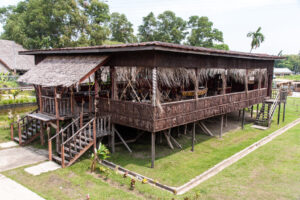
Architectural style of the Murut community known as Tulus and Pahun.
Functions
a) Built for safety and defense.
b) Noteworthy for having the house entrance at the side and featuring an elongated space separating family rooms.
c) In the central part, there’s a meeting area and a floor for dances or ceremonies.
Construction Materials:
Round wood, bark, tolidus leaves.
3. Lepa
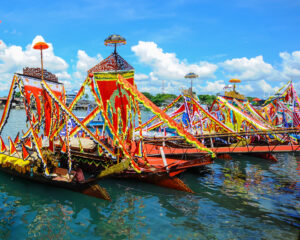
The Lepa is a marvel of craftsmanship, constructed from a variety of locally sourced woods, including obasuluk, seraya, mata-mata, and gagir. These materials are carefully selected for their durability and buoyancy, ensuring the boat’s resilience against the challenges of the open sea. The construction also involves a meticulous process, with each piece carefully fitted together to create a vessel capable of navigating both calm waters and challenging currents.
A boat crafted by the Bajau/Sama community.
Functions:
a) Transporting goods.
b) Residential space.
Construction Materials:
a) Made from various types of wood like obasuluk, seraya, mata-mata, and gagir.
b) Its roof is crafted from nipa palm leaves.
How to get there?
You can find out the schedule and location of the Lepa Regatta Festival which typically takes place in Semporna, Sabah, and features a colorful display of traditional lepa boats. Usually the event is famous Dragon Boat Race taking place every year in April in Semporna.
Consider flying to Tawau Airport, which is the nearest airport to Semporna. From there, you can take a bus, taxi, or arrange transportation to Semporna.
Once in Semporna during the festival, you’ll have the opportunity to witness the Lepa boats, cultural performances, and other festivities. The festival usually attracts both locals and tourists.
Arts and Crafts
Arts and crafts play a crucial role in preserving the cultural identity of Sabah’s indigenous communities. These crafts are not just objects; they are embodiments of stories, traditions, and a deep connection to the surrounding environment
1. Fabric Crafts
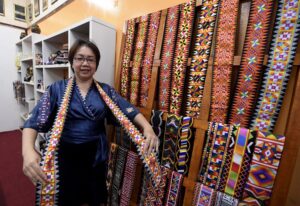
a) Inavol – The Rungus people skillfully create Inavol, producing vibrant scarves.The process of making Inavol involves skilled craftsmanship. The weavers use traditional methods to create intricate patterns and designs on the scarves. While the scarves are appreciated for their artistic qualities, they also serve a practical purpose. They can be worn for warmth, especially in the cooler climate of certain regions.
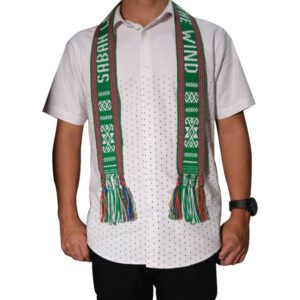
b) Dastar – The Iranum community makes Dastar fabric commonly used as headgear.The fabric may be fashioned into traditional attire worn during important cultural events, celebrations, or ceremonies within the Iranun community.
In the craft of fabric, the Rungus make colorful scarves called Inavol, while the Iranum create Dastar fabric used as headgear.
2. Handicrafts
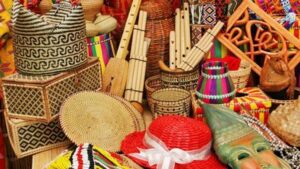
a) Wakid Used for carrying large items. The design and construction of the Wakid may vary among different communities, reflecting local preferences, available resources, and traditional craftsmanship. It serves as an essential tool for daily activities, allowing individuals to transport goods, materials, or belongings in a convenient and efficient manner.
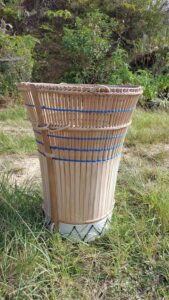
b) Buan – Serves as a storage place for belongings. The Buan is a traditional storage container or receptacle that has been crafted by the indigenous communities in Sabah. It is designed to store and organize various items, and its construction often involves locally available materials and traditional craftsmanship.
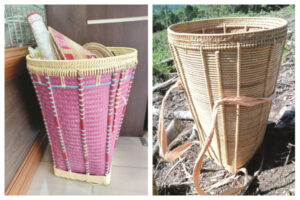
Handicraft items include Wakid for carrying big things, Tayen for transporting goods and wedding gifts, Buan as a storage place, and Duang (Snow Hood) made from Serdang leaves by the Bajau/Sama.
3) Craftsmanship
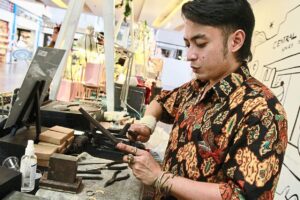
Craftsmanship involves tools like Guuk for cutting grass and Pida for wedding ceremonies. These tools reflect the intersection of practicality and cultural significance in the daily lives of the people in Sabah. On one hand, the Guuk addresses a common and practical need for managing the environment, while the Pida is intricately linked to cultural traditions, symbolizing the importance of rituals, particularly in the context of weddings
a) Guuk: Used for cutting grass
b) Pida: Used in wedding ceremonies.
Tips for someone attending for the first time
Just be open-minded, show respect for their customs, and don’t be shy to ask questions. It’s all about embracing the experience and connecting with the vibrant Sabah culture.

